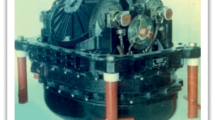Abstract
An active attitude control system (ACS) of an orbiting near-Earth spacecraft (SC), containing an on-board computer, a block of gyroscopic angular velocity sensors (BGAVS) and executive bodies (flywheels, gyrodines, jet engines), is considered. It is proposed to use magnetometers (MGM) installed along the coupled axes of the spacecraft as an external information sensor. We call such a system a magnetic-gyroscopic attitude control system (MGACS). It is shown that the use of MGM as an attitude sensor does not violate the functionality of the orientation of modern spacecraft and allows you to perform such flight modes as attitude restoration (AR) and program orientation of the spacecraft relative to the orbital coordinate system (OCS). The principle of construction of MGACS is stated, working algorithms are given, an estimate of orientation accuracy is given, simulation results are presented.




Similar content being viewed by others
REFERENCES
S. A. Babich and A. S. Kostjukov, “Review and comparsion of altitude control system of CubeSAT class nanosatellites,” in Proc. of Reshetnev Readings, 2014 (Reshetnev Univ., Krasnoyarsk, 2014), Vol. 1, pp. 495–497.
N. V. Efimenko and N. V. Lutsenko, “Synthesis of control for the spacecraft magnetic system of orientation and stabilization,” Radioelektr. Informat. Upravlen., No. 2(4), 121–124 (2000).
N. Ivlev, S. Karpinko, A. Sivkov, et al., “Development of microsatellite attitude determination and control system,” Mekh. Upravl. Informat. 6 (1), 43–60 (2014).
A. P. Kovalenko, Magnetic Control Systems of Spacecraft (Mashinostroenie, Moscow, 1975) [in Russian].
A. V. Kozakov, “Magnetogyroscopic system is a worthy rival to the gravitational orientation system on small satellites,” Vopr. Elektromekh. Tr. VNIIEM 100, 156–176 (2001).
A. V. Kramlikh and M. E. Melnik, “On-board algorithm for SamSat-218D nanosatellite orientation and stabilization system,” Vestn. Samarsk. Univ. Aerokosm. Tekh. Tekhnol. Mashinostr. 15 (2), 50–56 (2016). https://doi.org/10.18287/2412-7329-2016-15-2-50-56
D. Lebedev, A. Tkachenko, and Yu.N. Shtepa, “Magnetic system for controlling the angular motion of a micro-satellite,” Kosm. Nauka Tekhnol. 2 (5-6), 17–25 (1996). https://doi.org/10.15407/knit1996.05.017
V. M. Morozov and V. I. Kalenova, “Satellite control using magnetic moments: controllability and stabilization algorithms,” Cosmic. Res. 58, 158–166 (2020). https://doi.org/10.1134/S0010952520030041
I. N. Abezyaev, P. E. Velichko, A. A. Karpunin, et al., “Development of the algorithm of the spacecraft programmed yaw turns with the use of orbital gyrocompass,” AIP Conf. Proc. 2171 (1), 060009 (2019). https://doi.org/10.1063/1.5133207
M. Abdelrahman and S.-Y. Park, “Simultaneous spacecraft attitude and orbit estimation using magnetic field vector measurements,” Aerosp. Sci. Technol. 15 (8), 653–669 (2011). https://doi.org/10.1016/j.ast.2011.01.006
F. Gulmammadov, O. Kahraman, C. Yavuzyilmaz, et al., “Magnetorquers only attitude maintaining using dynamic attitude simulator environment,” in AIAA Modeling and Simulation Technologies Conference, Toronto, 2010 (AIAA, 2010), pp. 8106. https://doi.org/10.2514/6.2010-8106
M. Lovera and A. Astolfi, “Global magnetic attitude control of inertially pointing spacecraft,” J. Guid. Contr. Dyn. 28 (5), 1065–1072 (2005). https://doi.org/10.2514/1.11844
F. Della Rossa, M. Bergamasco, and M. Lovera, “Bifurcation analysis of the attitude dynamics for a magnetically controlled spacecraft,” in 2012 IEEE 51st IEEE Conference on Decision and Control (CDC) (IEEE, 2012), pp. 1154–1159. https://doi.org/10.1109/CDC.2012.6426150
E. Silani and M. Lovera, “Magnetic spacecraft attitude control: a survey and some new results,” Contr. Eng. Pract. 13 (3), 357–371 (2005). https://doi.org/10.1016/j.conengprac.2003.12.017
P. Wang, Y. Shtessel, and Y.-Q. Wang, “Satellite attitude control using only magnetorquers,” in Proceedings of the Thirtieth Southeastern Symposium on System Theory (IEEE, 1998), pp. 500–504. https://doi.org/10.1109/SSST.1998.660124
I. N. Abezyaev, “Hybrid orientation system for orbital spacecraft,” Mech. Solids 56, 471–477 (2021). https://doi.org/10.3103/S0025654421040026
V. N. Branets and I. P. Shmyglevsky, “Application of quaternions in controlling the angular position of a solid body,” Izv. Akad. Nauk SSSR Mekh. Tverd. Tela, No. 4, 24–31 (1972).
International Geomagnetic Reference Field (IGRF), https://www.ngdc.noaa.gov/IAGA/vmod/igrf.html
GOST 25645.126-85 Geomagnetic Field. A Model of the field Inside Terrestrial Sources (Gosstandart SSSR, Moscow, 1987) [in Russian].
H. Goldstein, Classical Mechanics (Addison-Wesley, 1951; Nauka, Moscow, 1975).
M. Yu. Belyaev, M. I. Monakhov, and V. V. Sazonov, “Accuracy estimation of the magnetometer measurements onboard Service Module of ISS,” Preprint No. 54, KIAM (KIAM, Moscow, 2012) [in Russian].
Author information
Authors and Affiliations
Corresponding author
Additional information
Translated by I. K. Katuev
About this article
Cite this article
Abezyaev, I.N. On One Possibility of Orientation of a Near-Earth Spacecraft in the Earth’s Magnetic Field. Mech. Solids 57, 1323–1329 (2022). https://doi.org/10.3103/S0025654422060012
Received:
Revised:
Accepted:
Published:
Issue Date:
DOI: https://doi.org/10.3103/S0025654422060012




